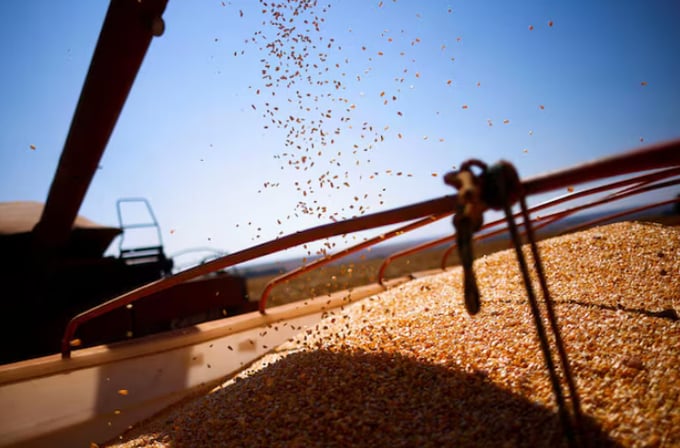November 26, 2025 | 20:15 GMT +7
November 26, 2025 | 20:15 GMT +7
Hotline: 0913.378.918
November 26, 2025 | 20:15 GMT +7
Hotline: 0913.378.918

Corn grains are loaded on a truck after being harvested at a farm near Brasilia, Brazil August 22, 2023. Photo: REUTERS/Adriano Machado.
Likewise, "China" and "imports" are often synonymous in global soybean trade because the country accounts for more than 60% of annual imports.
But what about the other customers? Who takes in the other 40% of soy cargoes, and how have these trends changed in recent years, especially with respect to each supplier?
This conversation has been pulled to the forefront of the market as the United States has threatened tariffs on many of its trade partners, who are contemplating measures of their own. This includes both Mexico and European Union countries, top destinations for U.S. farm goods.
At the same time, Brazil’s ballooning soybean crop has been increasingly able to supply global needs, slowly chipping away at U.S. soy exporters’ relevance.
China significantly reduced its reliance on U.S. soybeans during the first trade war in 2018, though that was largely possible at the time because of widespread disease throughout its hog herd, which significantly dented feed demand.
But for U.S. exporters, the pre-trade war levels were never restored, and U.S. soy shipments to China over the last three calendar years have fallen 12% from the 2015-2017 average. China increased its imports by 13% during that time.
Also during this time, Brazil expanded its soy exports to China by 51%, less than the 61% rise in the country’s total shipments. By comparison, U.S. soy exports to all destinations declined 2% in the same period as the focus on domestic demand increased.
On average over the last three years, about 72% of Brazil’s soy exports headed to China, compared with 76% between 2015-2017. This huge dependence on a single customer is perhaps the biggest vulnerability of Brazil’s export program.
About 53% of U.S. soy exports were destined for China over the last three calendar years compared with a three-year, pre-trade-war average of 59%.
European Union countries are collectively the second-largest soybean importing entity, accounting for about 8% of the global total. The EU is also the No. 2 destination for both Brazilian and U.S. soybeans.
Around 2000, Europe was Brazil’s present-day China, consuming almost two-thirds of the country’s soy exports. That share has averaged just 7% in the latest three years, though the volumes have risen over the last decade.
U.S. soy exports to the EU have also risen in recent years, though the average volumes remain slightly lower than those from Brazil. EU countries accounted for about 11% of U.S. shipments over the last three years.
However, U.S. soybean trade with the EU, which grossed $2.4 billion last year, could be in jeopardy. Brussels is expected on Wednesday to publish a policy potentially restricting agricultural imports treated with chemicals banned in Europe.
That could force U.S. exporters to explore new markets, assuming trade relations allow. Mexico is the United States’ second largest single-country soybean destination, accounting for about 10% of the annual total, though tariff threats also loom there.
Total Brazilian soy exports are nearly 80% larger by volume than their U.S. counterparts, but both countries over the last three years exported similar volumes to destinations other than China and the EU. This relatively greater diversity among the United States’ customers might be its only present advantage over Brazil’s booming business.
The future of U.S. soy exports could become less worrisome if domestic demand were to escalate in a manner implied by the aggressive biofuel mandates floated a few years ago.
But those plans, much like the tariff discussions, are in a holding pattern for now. This means that if the upcoming U.S. soy crop is not sufficiently large, next season’s shipments could be squeezed further.
(Reuters)
/2025/11/24/3616-2-141832_513.jpg)
(VAN) FSC certification has helped increase the value of thousands of hectares of planted forest timber under the management of the Xuan Loc Protection Forest Management Board, particularly in terms of selling prices.

(VAN) More than 100 shoppers queued for a chance to get a kilo or so of Japanese rice for 500 yen ($3.32) by heaping as much grain into a small wooden box as possible.

(VAN) Benchmark international prices of milled declined in October as harvests started or improved in some parts of the globe.

(VAN) Show cause orders will be issued to retailers who sell imported rice at prices exceeding the maximum suggested retail price (MSRP) of P43 per kilo, Philippines Agriculture Secretary said in a statement on Thursday.

(VAN) Coffee prices on October 20, 2025, remained stable domestically, trading at 113,500–114,500 VND/kg. Similarly, global coffee prices also moved sideways.

(VAN) By October, Vietnam’s coffee exports had surpassed USD 7 billion for the first time and will exceed USD 8 billion within this year.

(VAN) Illinois rancher says Texas, Oklahoma, Kansas lost grass and forage, forcing massive cattle liquidation.